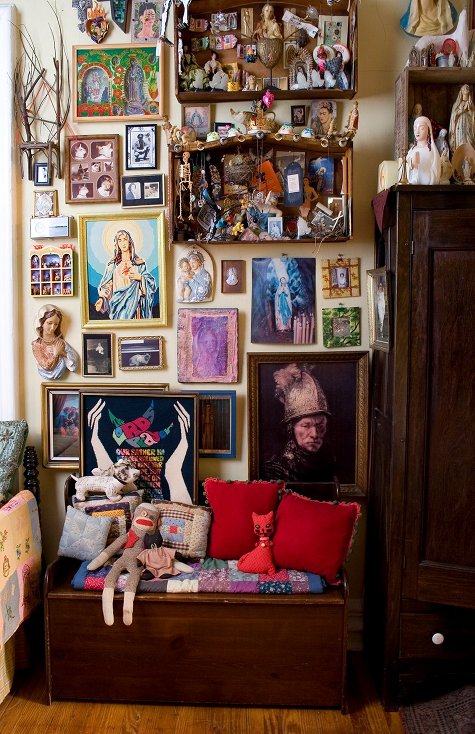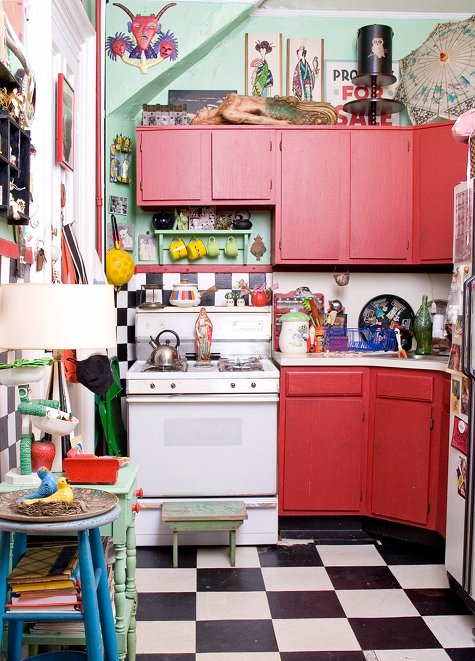Clutter, objects, joy
Posted Under: Things/Thinking
When Unhappy Hipsters started making the rounds, I linked to it from the Consumed Facebook page, where Braulio alerted me (thanks again) to this Psychology Today column by Ingrid Fetell, asking: “Are there elements of modern design that inherently make us feel gloomy?” Her answer klonopin is that, in fact, there might be.
Modern design was born out of a desire to leave (https://www.pawsgistclinic.org.uk/stromectol-ivermectin/) behind the ornamentation and excesses of 19th century Europe. In essence, it’s a stripped back, pared down style of design, favoring clean, often angular lines, neutral colors in tones of gray and beige, bare materials, and a general sense of spareness and minimalism….
She’s generalizing, of course, and at first that doesn’t sound so bad. But then she notes research on emotional responses to color, and angular vs. curved forms. The short summary would be that many of the tropes of “modern” design are at odds with good vibes. “I think,” she writes, “that modernism’s restrained quality is fundamentally in tension with the idea of delight. Delight is an emotion of abundance — a celebration of sensation and richness. Delight and joy are primally connected to wellness, and wellness in nature is lush, plump, vibrant, and bountiful.” (Fetell also has a project/blog called Aesthetics of Joy, here.)
I am somewhat cautious about that connection between delight and abundance. Buying into that idea full-on would be emotionally catastrophic — I mean, maybe those “hipsters” are unhappy, but watch an episode of Hoarders and decide for yourself how delightful that abundance seems.
But on some level I think Fetell has a point. Just yesterday I was browsing Design*Sponge and I was struck by the “sneak peek” pictures of Michael Quinn’s apartment. (Two examples, above and below.) I wrote here earlier about how much I enjoy D*S’s “sneak peek” series pictures: “They’re interesting because they’re so unlike the spare and clinical celexa interiors often featured in more mainstream Design Think contexts, such as certain shelter magazines (not to mention catalogs) and the like, where the decor is always minimal, and there’s no clutter beyond one or two art books.”
Misgivings aside, then, I’d still rather look at these pictures than what I see celebrated in most sharp-and-clean-focused “good design” sources.
The combination of Fetell’s piece and these D*S images actually brought to mind a number of topics I’ve pondered here in the past — the visual jumble of MySpace, the more recent post about groups of stuff, and of course the significance of otherwise-oddball-seeming-objects.
What do you think? Is clean, spare design a bummer? Is the notion of clutter-abundance delightful — or a rationale that dead ends unpleasantly?




 "
"














 Kim Fellner's book
Kim Fellner's book  A
A
Reader Comments
I have often wondered whether a large part of the trend towards minimalism in shelter aspirations derives from the desire to “photograph well” rather than “to produce feelings of well-being from being there”. I would generalize that to all of 20th C architecture, actually.
Also i think there are aspects of the desire for shelter minimalism that derive from a wish for to simplify one’s life, ie lower mental stress. “If i lived there my live would be sooooo ‘Zen'”.
This is explicit, of course, in some magazines’ titles. Managing a house construction or reconstruction or even a re-decorating project, OTOH, even if the result is an actual Zen garden, is anything but simplifying, in my direct experience!
One other observation: clutter is time-consuming to clean or dust, and dust-covered clutter is pretty gross. Which seems to be a good reason to favor minimalism. However, minimalist, Dwell-style homes look messy with the slightest amount of normal everyday disorder.
Clutter often makes many people feel comfortable.
The few ultra-modern homes I’ve been in often feel cold and impersonal just visiting, so I couldn’t imagine what it would be like to live there. And as the above commenter said “Dwell-style homes look messy with the slightest amount of normal everyday disorder.”
Give me a few knick-knacks any day to liven up the place!
I think we are over-thinking things. I think the popularity of Unhappy Hipsters does not suggest that spare minimalism is somehow depressing or “gloomy”. We delight in Unhappy Hipsters because we are all just plain jealous. We are jealous of these beautiful, slim, fashionable people in their fantastic modern homes filled with DWR furniture. We subscribe to these magazines and catalogs because this is the lifestyle we aspire to, and we drool over these photographs, trying not to feel inadequate. A site like Unhappy Hipsters allows us to briefly laugh at this “perfection” instead.
personally, i love minimalism at home after a day in my cluttered studio!